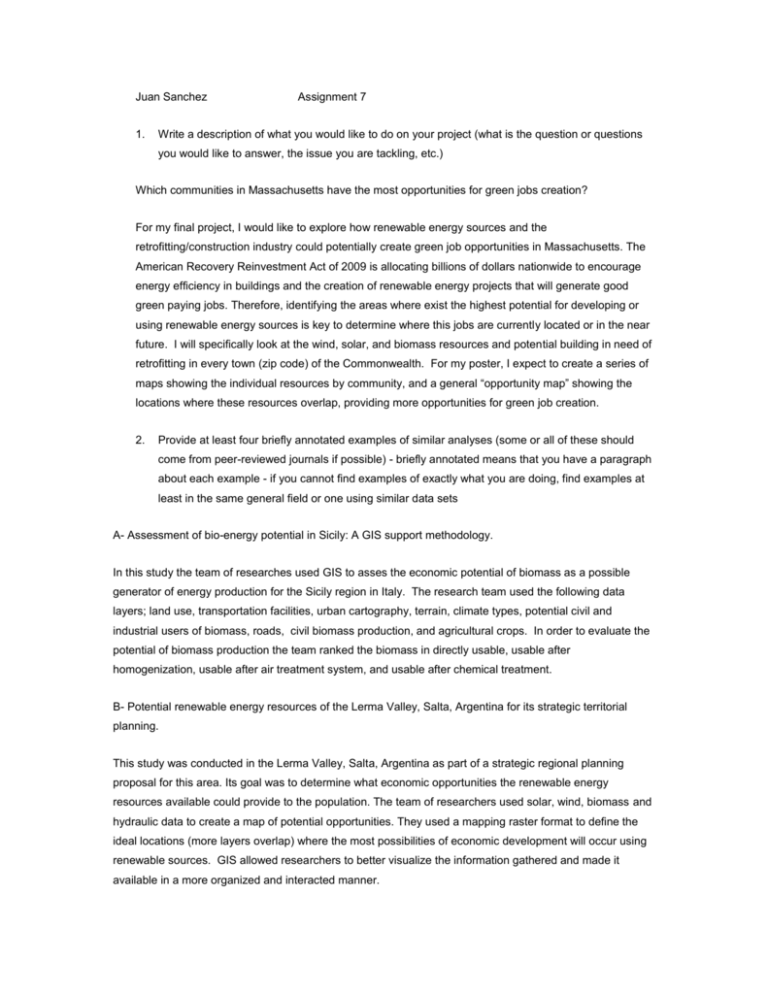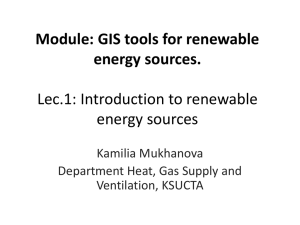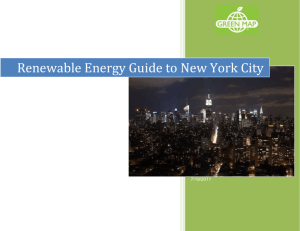assig 7 write up
advertisement

Juan Sanchez 1. Assignment 7 Write a description of what you would like to do on your project (what is the question or questions you would like to answer, the issue you are tackling, etc.) Which communities in Massachusetts have the most opportunities for green jobs creation? For my final project, I would like to explore how renewable energy sources and the retrofitting/construction industry could potentially create green job opportunities in Massachusetts. The American Recovery Reinvestment Act of 2009 is allocating billions of dollars nationwide to encourage energy efficiency in buildings and the creation of renewable energy projects that will generate good green paying jobs. Therefore, identifying the areas where exist the highest potential for developing or using renewable energy sources is key to determine where this jobs are currently located or in the near future. I will specifically look at the wind, solar, and biomass resources and potential building in need of retrofitting in every town (zip code) of the Commonwealth. For my poster, I expect to create a series of maps showing the individual resources by community, and a general “opportunity map” showing the locations where these resources overlap, providing more opportunities for green job creation. 2. Provide at least four briefly annotated examples of similar analyses (some or all of these should come from peer-reviewed journals if possible) - briefly annotated means that you have a paragraph about each example - if you cannot find examples of exactly what you are doing, find examples at least in the same general field or one using similar data sets A- Assessment of bio-energy potential in Sicily: A GIS support methodology. In this study the team of researches used GIS to asses the economic potential of biomass as a possible generator of energy production for the Sicily region in Italy. The research team used the following data layers; land use, transportation facilities, urban cartography, terrain, climate types, potential civil and industrial users of biomass, roads, civil biomass production, and agricultural crops. In order to evaluate the potential of biomass production the team ranked the biomass in directly usable, usable after homogenization, usable after air treatment system, and usable after chemical treatment. B- Potential renewable energy resources of the Lerma Valley, Salta, Argentina for its strategic territorial planning. This study was conducted in the Lerma Valley, Salta, Argentina as part of a strategic regional planning proposal for this area. Its goal was to determine what economic opportunities the renewable energy resources available could provide to the population. The team of researchers used solar, wind, biomass and hydraulic data to create a map of potential opportunities. They used a mapping raster format to define the ideal locations (more layers overlap) where the most possibilities of economic development will occur using renewable sources. GIS allowed researchers to better visualize the information gathered and made it available in a more organized and interacted manner. C- Wind energy potential mapping in Karnataka, India, using GIS The purpose of this study was to map the wind potential in the province of Kamataka, India. The study used GIS to analyze the variability of the wind speed considering spatial and seasonal aspects. The team of researches ranked the wind speed by poor, marginal, good to very good, and excellent in order to categorize the wind potential of the area. This categorization was done by overlaying the thematic layers. D- Spatial data analysis and integration for regional-scale geothermal potential mapping, West Java, Indonesia This study was designed to map the potential geo-thermal resources in West Java, Indonesia using datadriven methods. The research team categorized the geo-thermal potential by weak negative, weak positive, strong negative, and strong positive, in order to identify the area with the most potential. The spatial data sets used for this analysis were; locations of geothermal prospects and hot springs, geological features, earthquake epicenters and “Bouguer” gravity data. 3. Describe the methods you think you will use (because we haven't covered analysis in detail yet, this may be very preliminary) I will use the political boundaries for the state of Massachusetts as the reference spatial area for this project. Then, I will download data for wind, biomass, and solar resource from the National Resource Energy Laboratory. I will also download a data set by census block groups of the housing structure age and housing amenities to obtain an approximation of the existing building structures in Massachusetts. Next, I will use the overlay tool to place the energy resource layers selected and the building layer “on top” of each other to determine where the most overlaps exists. Finally, I will break the data into quintiles to provide a rank of categories. The categories in this rank will be call, very low, low, moderate, high and very high. This categorization will identify the towns or areas with the most potential or green job creation in the state. 4. List the data layers you will need for this project (if you know where you will get them from, list the source, otherwise indicate that you will need help locating this data set) and include the minimum accuracy you will accept (e.g., for the location of a stream, does it need to be within 500 feet of its actual location or within 10 feet? Your answer will depend on your analysis purpose and the scale of your project). Note: This section of your report could take the form of a table with each data layer occupying one row. Data layer Source Accuracy Political boundaries for MA Mass Gis Not relevant Housing structure age in MA Mass Gis Census Not relevant Housing Amenities Mass Gis Census Not relevant Wind data for MA NREL Not relevant Biomass data for MA NREL Not relevant Solar data for MA NREL Not relevant References Beccali, Marco, Pietro Columba, Vincenzo D’Alberti, and Vincenzo Franzitta. 2009. Assessment of Bioenergy Potential in Sicily: A GIS-based support methodology. Biomass and Bioenergy 33, (1) (1): 79-87. Belmonte, S., V. Núñez, J. G. Viramonte, and J. Franco. Potential renewable energy resources of the Lerma Valley, Salta, Argentina for its strategic territorial planning. Renewable and Sustainable Energy Reviews In Press, Corrected Proof. Carranza, Emmanuel John M., Hendro Wibowo, Sally D. Barritt, and Prihadi Sumintadireja. 2008. Spatial data analysis and integration for regional-scale geothermal potential mapping, West Java, Indonesia. Geothermics 37, (3) (6): 267-99. Ramachandra, T. V., and B. V. Shruthi. 2005. Wind energy potential mapping in Karnataka, India, using GIS. Energy Conversion and Management 46, (9-10) (6): 1561-78.









